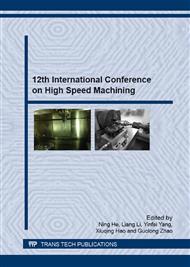p.304
p.310
p.318
p.326
p.333
p.340
p.348
p.359
p.369
Growth Time Optimization of Fine Grained Diamond Coated Drills for Machining CFRP
Abstract:
Carbon fiber reinforced plastics (CFRP), which are widely used in the aerospace and some other new-tech industries, are considered very difficult to machine due to the material anisotropic and inhomogeneous features. Chemical vapor deposition (CVD) diamond films are suitable as protective coatings on cutting tools for machining advanced composite materials, owing to their extremely high hardness, favorable wear resistance, low friction coefficient and high thermal conductivity. Among different types of diamond films, the fine grained diamond (FGD) film can provide much more favorable environment for machining CFRP due to the small grain size, low surface roughness and the retentivity for the sharpness of the cutting edge. In the present study, aiming at drilling CFRP, FGD films of different thicknesses are deposited on Φ3 mm drills by controlling the growth time, adopting the common-used hot filament CVD (HFCVD) technology. It can be directly proved by deposition experiments that overlong growth time can induce spontaneous film delamination and removal before the cooling stage, probably as a result of the excessive residual stress concentrated on the complicated surfaces. As demonstrated by the cutting tests, with increasing the growth time, the main failure mode of the FGD coated drill changes from film delamination to flank wear/tipping to film delamination, and the maximum tool life exists when the growth time is moderate, because the flimsy film cannot provide sufficient protective effects on the film-substrate interface and even hasn’t totally cover the substrate, while there’s relatively higher residual stress in the film that is too thick, and such the residual stress can significantly deteriorate the film-substrate adhesion. Moreover, during the life cycle of each FGD film, relatively shorter growth time often means the slightly better hole quality, attributed to the retentivity of the initial shape of the uncoated drill that is optimal designed for machining CFRP, especially the weaker passivation of the cutting edge.
Info:
Periodical:
Pages:
333-339
Citation:
Online since:
January 2016
Authors:
Keywords:
Price:
Сopyright:
© 2016 Trans Tech Publications Ltd. All Rights Reserved
Share:
Citation:


